Analysis of Organisational Training: Benefits and Drawbacks in HRM
VerifiedAdded on 2020/03/28
|10
|2204
|409
Essay
AI Summary
This essay examines the significance of organisational training in enhancing employee productivity and overall company development within the framework of human resource management. It explores how training programs contribute to a positive work environment, improved employee satisfaction, and effective recruitment and retention strategies. The essay also discusses the drawbacks, such as financial costs, time consumption, and the potential for employee disinterest or obsolescence of training due to technological advancements. The analysis highlights the need for strategic implementation of training programs tailored to the specific culture and requirements of the organisation. The essay concludes by emphasizing the importance of continuous assessment and adaptation of training strategies to meet the evolving needs of the business environment.
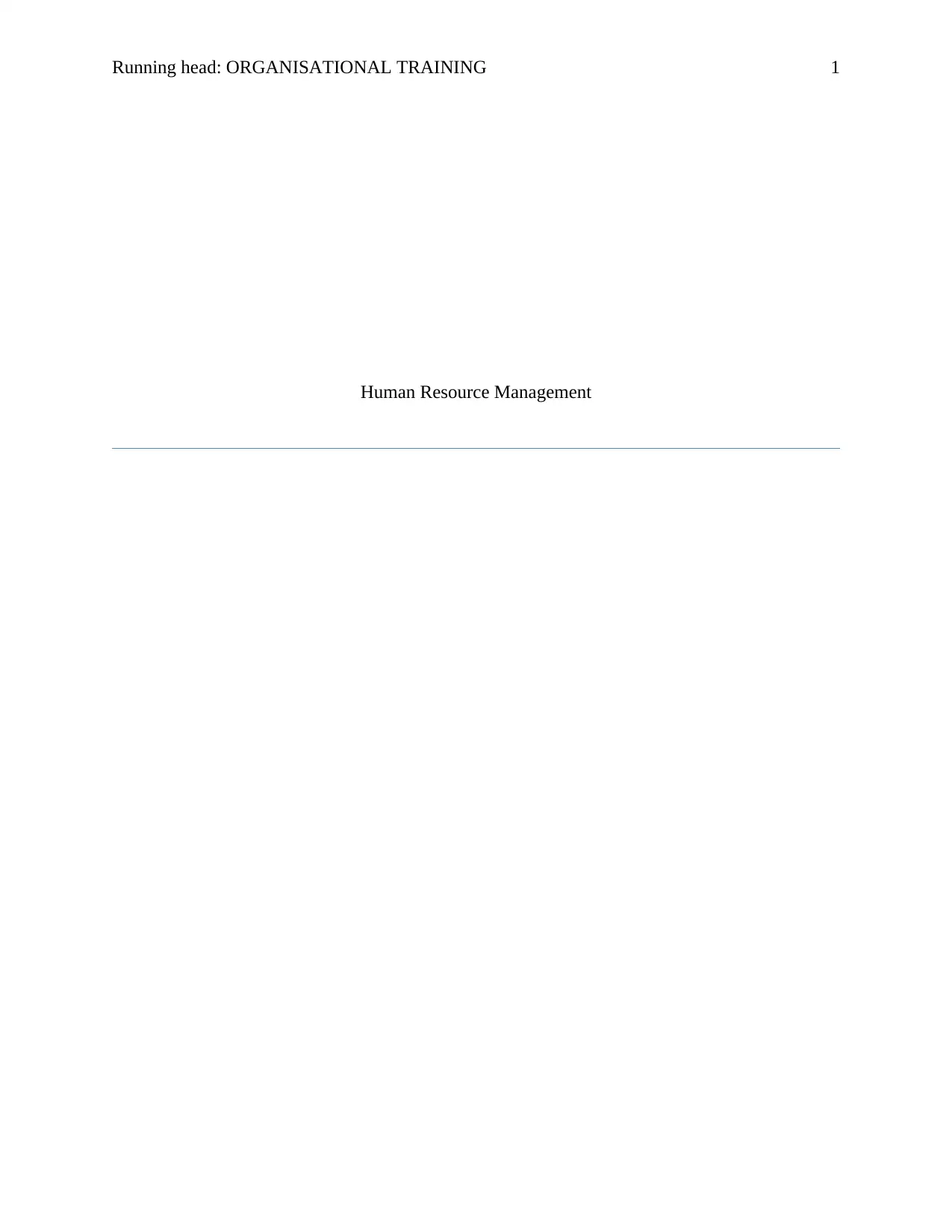
Running head: ORGANISATIONAL TRAINING 1
Human Resource Management
Human Resource Management
Paraphrase This Document
Need a fresh take? Get an instant paraphrase of this document with our AI Paraphraser
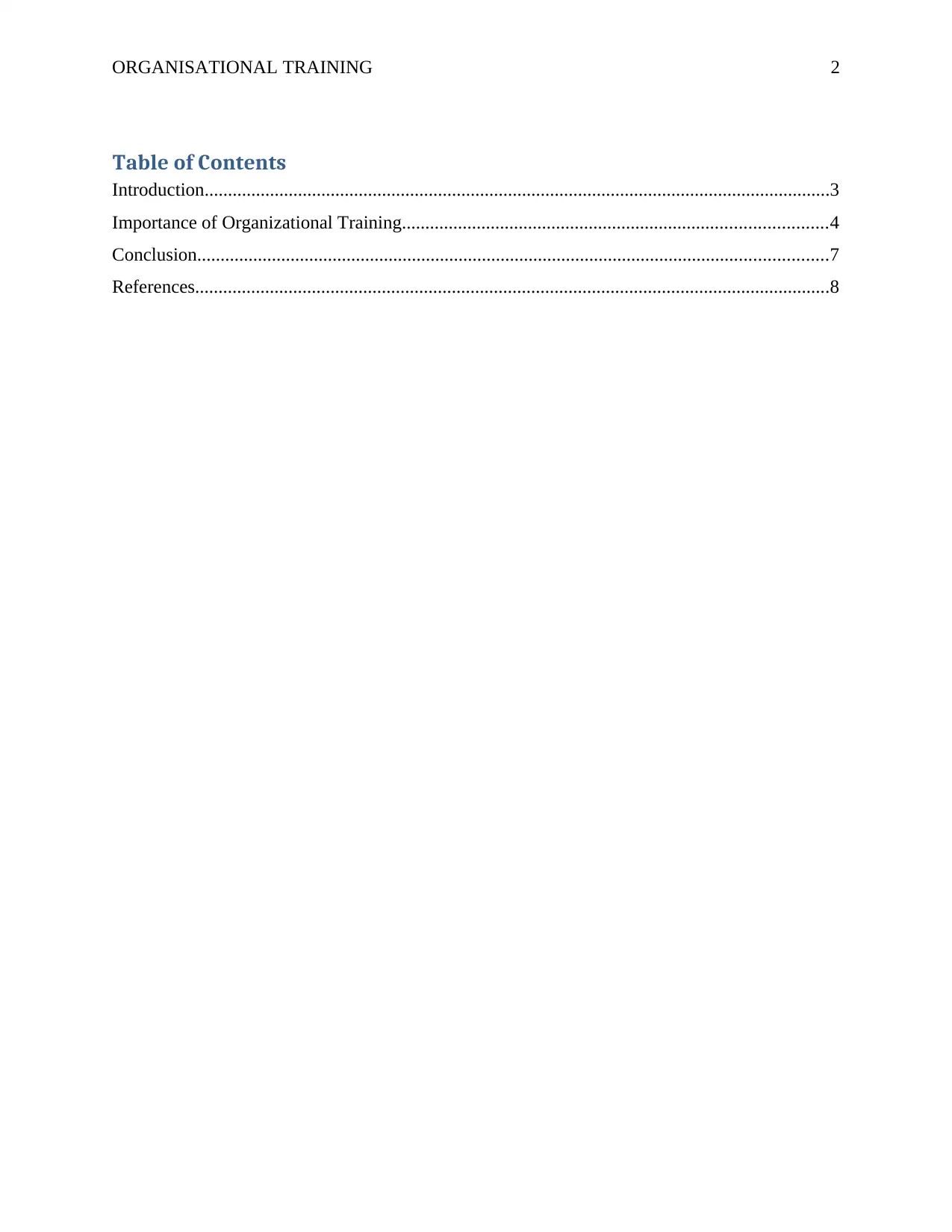
ORGANISATIONAL TRAINING 2
Table of Contents
Introduction......................................................................................................................................3
Importance of Organizational Training...........................................................................................4
Conclusion.......................................................................................................................................7
References........................................................................................................................................8
Table of Contents
Introduction......................................................................................................................................3
Importance of Organizational Training...........................................................................................4
Conclusion.......................................................................................................................................7
References........................................................................................................................................8
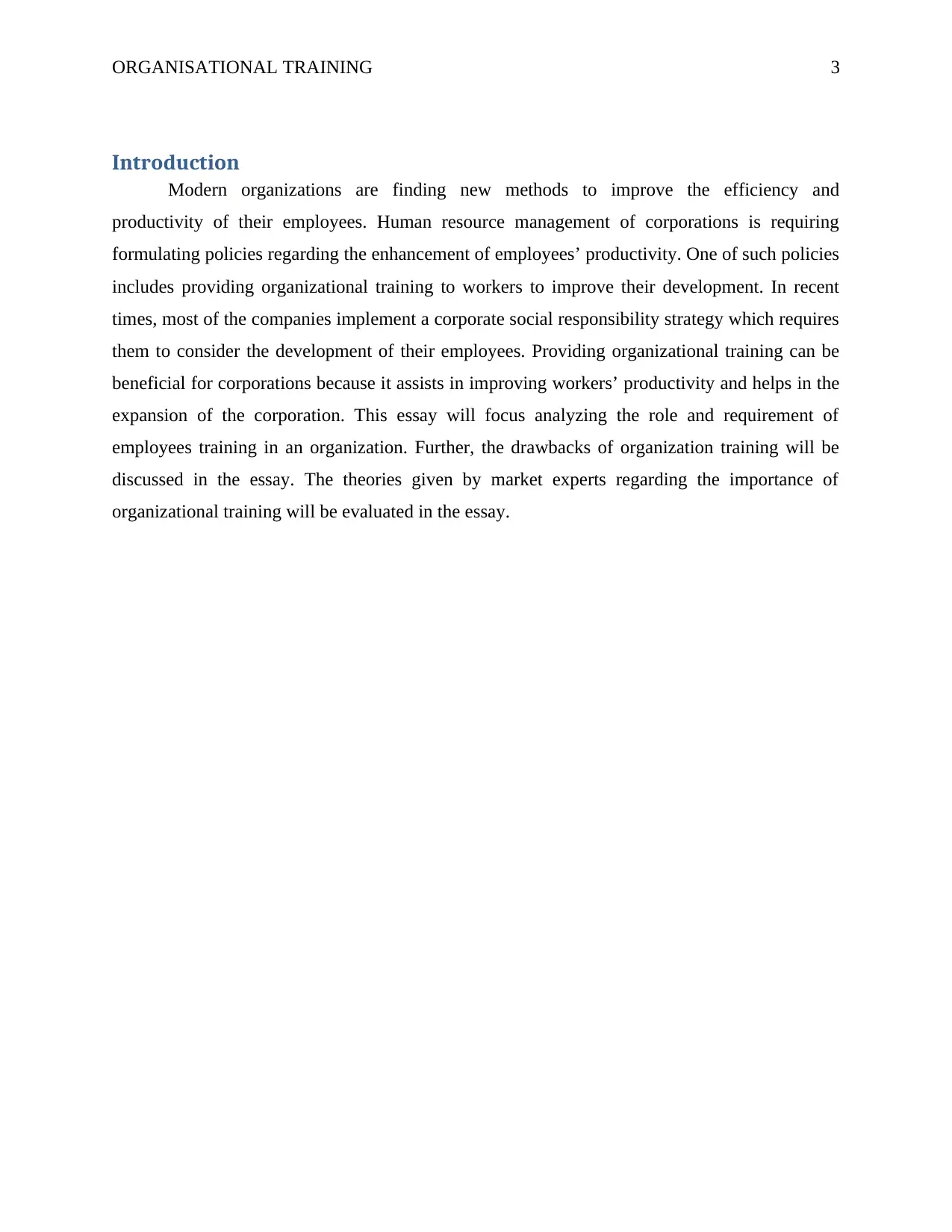
ORGANISATIONAL TRAINING 3
Introduction
Modern organizations are finding new methods to improve the efficiency and
productivity of their employees. Human resource management of corporations is requiring
formulating policies regarding the enhancement of employees’ productivity. One of such policies
includes providing organizational training to workers to improve their development. In recent
times, most of the companies implement a corporate social responsibility strategy which requires
them to consider the development of their employees. Providing organizational training can be
beneficial for corporations because it assists in improving workers’ productivity and helps in the
expansion of the corporation. This essay will focus analyzing the role and requirement of
employees training in an organization. Further, the drawbacks of organization training will be
discussed in the essay. The theories given by market experts regarding the importance of
organizational training will be evaluated in the essay.
Introduction
Modern organizations are finding new methods to improve the efficiency and
productivity of their employees. Human resource management of corporations is requiring
formulating policies regarding the enhancement of employees’ productivity. One of such policies
includes providing organizational training to workers to improve their development. In recent
times, most of the companies implement a corporate social responsibility strategy which requires
them to consider the development of their employees. Providing organizational training can be
beneficial for corporations because it assists in improving workers’ productivity and helps in the
expansion of the corporation. This essay will focus analyzing the role and requirement of
employees training in an organization. Further, the drawbacks of organization training will be
discussed in the essay. The theories given by market experts regarding the importance of
organizational training will be evaluated in the essay.
⊘ This is a preview!⊘
Do you want full access?
Subscribe today to unlock all pages.

Trusted by 1+ million students worldwide
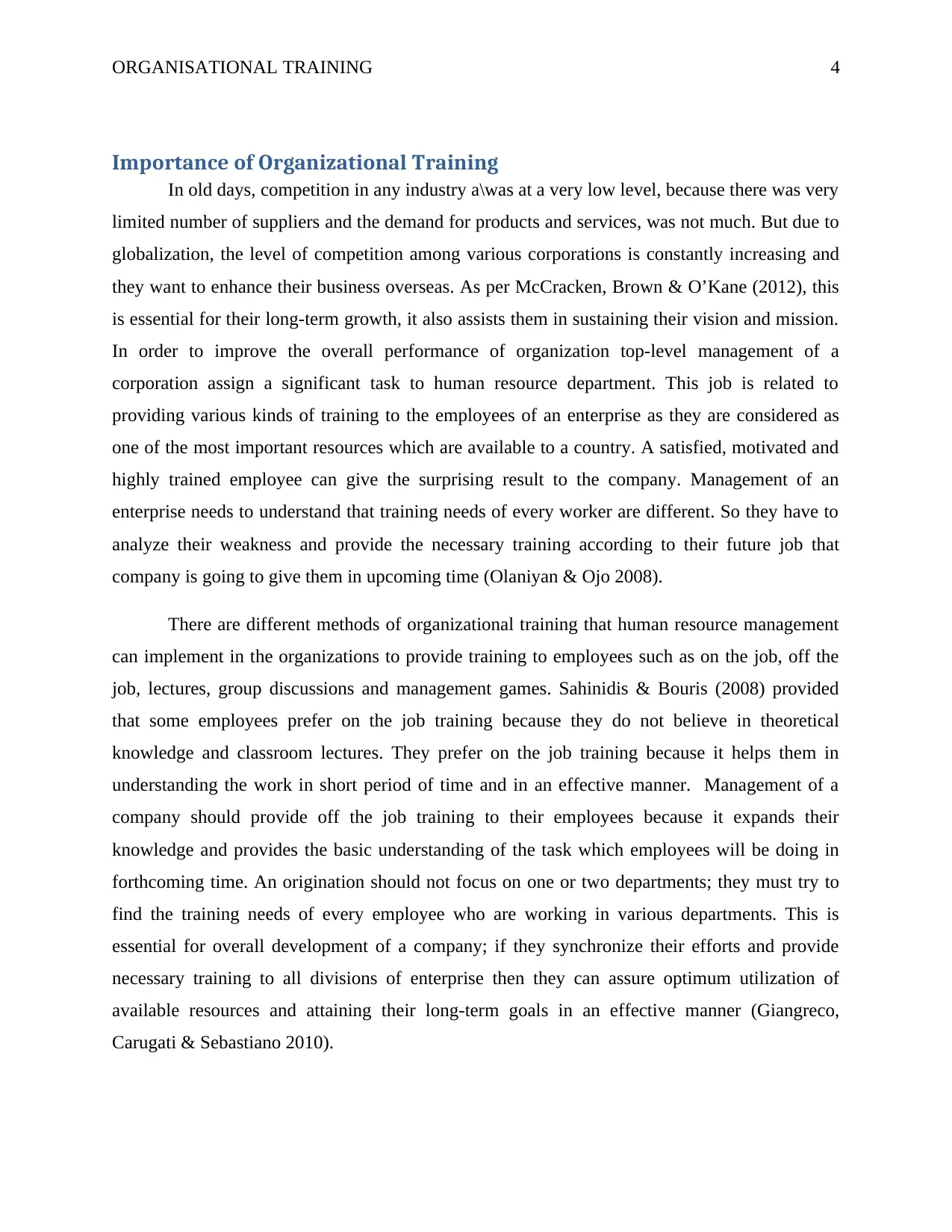
ORGANISATIONAL TRAINING 4
Importance of Organizational Training
In old days, competition in any industry a\was at a very low level, because there was very
limited number of suppliers and the demand for products and services, was not much. But due to
globalization, the level of competition among various corporations is constantly increasing and
they want to enhance their business overseas. As per McCracken, Brown & O’Kane (2012), this
is essential for their long-term growth, it also assists them in sustaining their vision and mission.
In order to improve the overall performance of organization top-level management of a
corporation assign a significant task to human resource department. This job is related to
providing various kinds of training to the employees of an enterprise as they are considered as
one of the most important resources which are available to a country. A satisfied, motivated and
highly trained employee can give the surprising result to the company. Management of an
enterprise needs to understand that training needs of every worker are different. So they have to
analyze their weakness and provide the necessary training according to their future job that
company is going to give them in upcoming time (Olaniyan & Ojo 2008).
There are different methods of organizational training that human resource management
can implement in the organizations to provide training to employees such as on the job, off the
job, lectures, group discussions and management games. Sahinidis & Bouris (2008) provided
that some employees prefer on the job training because they do not believe in theoretical
knowledge and classroom lectures. They prefer on the job training because it helps them in
understanding the work in short period of time and in an effective manner. Management of a
company should provide off the job training to their employees because it expands their
knowledge and provides the basic understanding of the task which employees will be doing in
forthcoming time. An origination should not focus on one or two departments; they must try to
find the training needs of every employee who are working in various departments. This is
essential for overall development of a company; if they synchronize their efforts and provide
necessary training to all divisions of enterprise then they can assure optimum utilization of
available resources and attaining their long-term goals in an effective manner (Giangreco,
Carugati & Sebastiano 2010).
Importance of Organizational Training
In old days, competition in any industry a\was at a very low level, because there was very
limited number of suppliers and the demand for products and services, was not much. But due to
globalization, the level of competition among various corporations is constantly increasing and
they want to enhance their business overseas. As per McCracken, Brown & O’Kane (2012), this
is essential for their long-term growth, it also assists them in sustaining their vision and mission.
In order to improve the overall performance of organization top-level management of a
corporation assign a significant task to human resource department. This job is related to
providing various kinds of training to the employees of an enterprise as they are considered as
one of the most important resources which are available to a country. A satisfied, motivated and
highly trained employee can give the surprising result to the company. Management of an
enterprise needs to understand that training needs of every worker are different. So they have to
analyze their weakness and provide the necessary training according to their future job that
company is going to give them in upcoming time (Olaniyan & Ojo 2008).
There are different methods of organizational training that human resource management
can implement in the organizations to provide training to employees such as on the job, off the
job, lectures, group discussions and management games. Sahinidis & Bouris (2008) provided
that some employees prefer on the job training because they do not believe in theoretical
knowledge and classroom lectures. They prefer on the job training because it helps them in
understanding the work in short period of time and in an effective manner. Management of a
company should provide off the job training to their employees because it expands their
knowledge and provides the basic understanding of the task which employees will be doing in
forthcoming time. An origination should not focus on one or two departments; they must try to
find the training needs of every employee who are working in various departments. This is
essential for overall development of a company; if they synchronize their efforts and provide
necessary training to all divisions of enterprise then they can assure optimum utilization of
available resources and attaining their long-term goals in an effective manner (Giangreco,
Carugati & Sebastiano 2010).
Paraphrase This Document
Need a fresh take? Get an instant paraphrase of this document with our AI Paraphraser
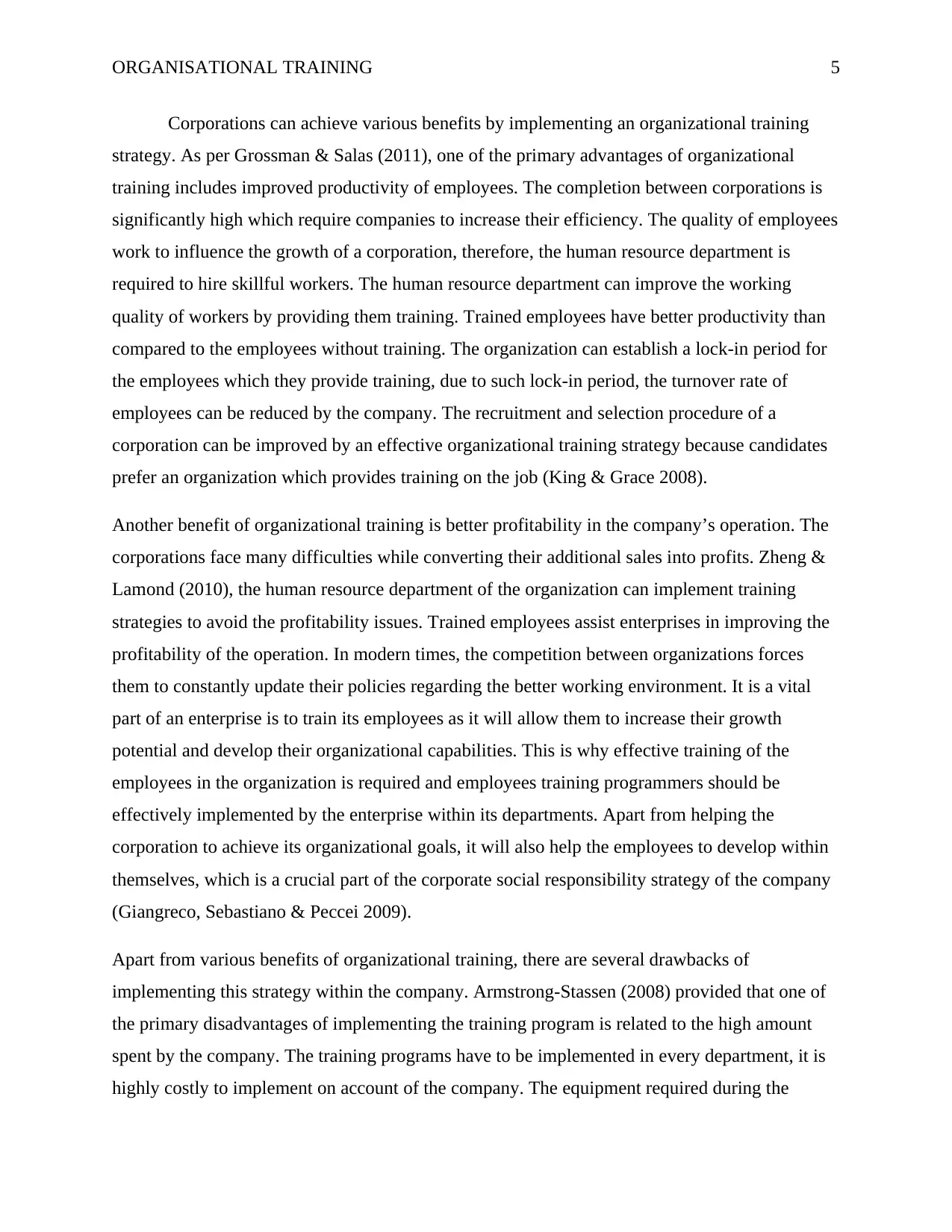
ORGANISATIONAL TRAINING 5
Corporations can achieve various benefits by implementing an organizational training
strategy. As per Grossman & Salas (2011), one of the primary advantages of organizational
training includes improved productivity of employees. The completion between corporations is
significantly high which require companies to increase their efficiency. The quality of employees
work to influence the growth of a corporation, therefore, the human resource department is
required to hire skillful workers. The human resource department can improve the working
quality of workers by providing them training. Trained employees have better productivity than
compared to the employees without training. The organization can establish a lock-in period for
the employees which they provide training, due to such lock-in period, the turnover rate of
employees can be reduced by the company. The recruitment and selection procedure of a
corporation can be improved by an effective organizational training strategy because candidates
prefer an organization which provides training on the job (King & Grace 2008).
Another benefit of organizational training is better profitability in the company’s operation. The
corporations face many difficulties while converting their additional sales into profits. Zheng &
Lamond (2010), the human resource department of the organization can implement training
strategies to avoid the profitability issues. Trained employees assist enterprises in improving the
profitability of the operation. In modern times, the competition between organizations forces
them to constantly update their policies regarding the better working environment. It is a vital
part of an enterprise is to train its employees as it will allow them to increase their growth
potential and develop their organizational capabilities. This is why effective training of the
employees in the organization is required and employees training programmers should be
effectively implemented by the enterprise within its departments. Apart from helping the
corporation to achieve its organizational goals, it will also help the employees to develop within
themselves, which is a crucial part of the corporate social responsibility strategy of the company
(Giangreco, Sebastiano & Peccei 2009).
Apart from various benefits of organizational training, there are several drawbacks of
implementing this strategy within the company. Armstrong-Stassen (2008) provided that one of
the primary disadvantages of implementing the training program is related to the high amount
spent by the company. The training programs have to be implemented in every department, it is
highly costly to implement on account of the company. The equipment required during the
Corporations can achieve various benefits by implementing an organizational training
strategy. As per Grossman & Salas (2011), one of the primary advantages of organizational
training includes improved productivity of employees. The completion between corporations is
significantly high which require companies to increase their efficiency. The quality of employees
work to influence the growth of a corporation, therefore, the human resource department is
required to hire skillful workers. The human resource department can improve the working
quality of workers by providing them training. Trained employees have better productivity than
compared to the employees without training. The organization can establish a lock-in period for
the employees which they provide training, due to such lock-in period, the turnover rate of
employees can be reduced by the company. The recruitment and selection procedure of a
corporation can be improved by an effective organizational training strategy because candidates
prefer an organization which provides training on the job (King & Grace 2008).
Another benefit of organizational training is better profitability in the company’s operation. The
corporations face many difficulties while converting their additional sales into profits. Zheng &
Lamond (2010), the human resource department of the organization can implement training
strategies to avoid the profitability issues. Trained employees assist enterprises in improving the
profitability of the operation. In modern times, the competition between organizations forces
them to constantly update their policies regarding the better working environment. It is a vital
part of an enterprise is to train its employees as it will allow them to increase their growth
potential and develop their organizational capabilities. This is why effective training of the
employees in the organization is required and employees training programmers should be
effectively implemented by the enterprise within its departments. Apart from helping the
corporation to achieve its organizational goals, it will also help the employees to develop within
themselves, which is a crucial part of the corporate social responsibility strategy of the company
(Giangreco, Sebastiano & Peccei 2009).
Apart from various benefits of organizational training, there are several drawbacks of
implementing this strategy within the company. Armstrong-Stassen (2008) provided that one of
the primary disadvantages of implementing the training program is related to the high amount
spent by the company. The training programs have to be implemented in every department, it is
highly costly to implement on account of the company. The equipment required during the
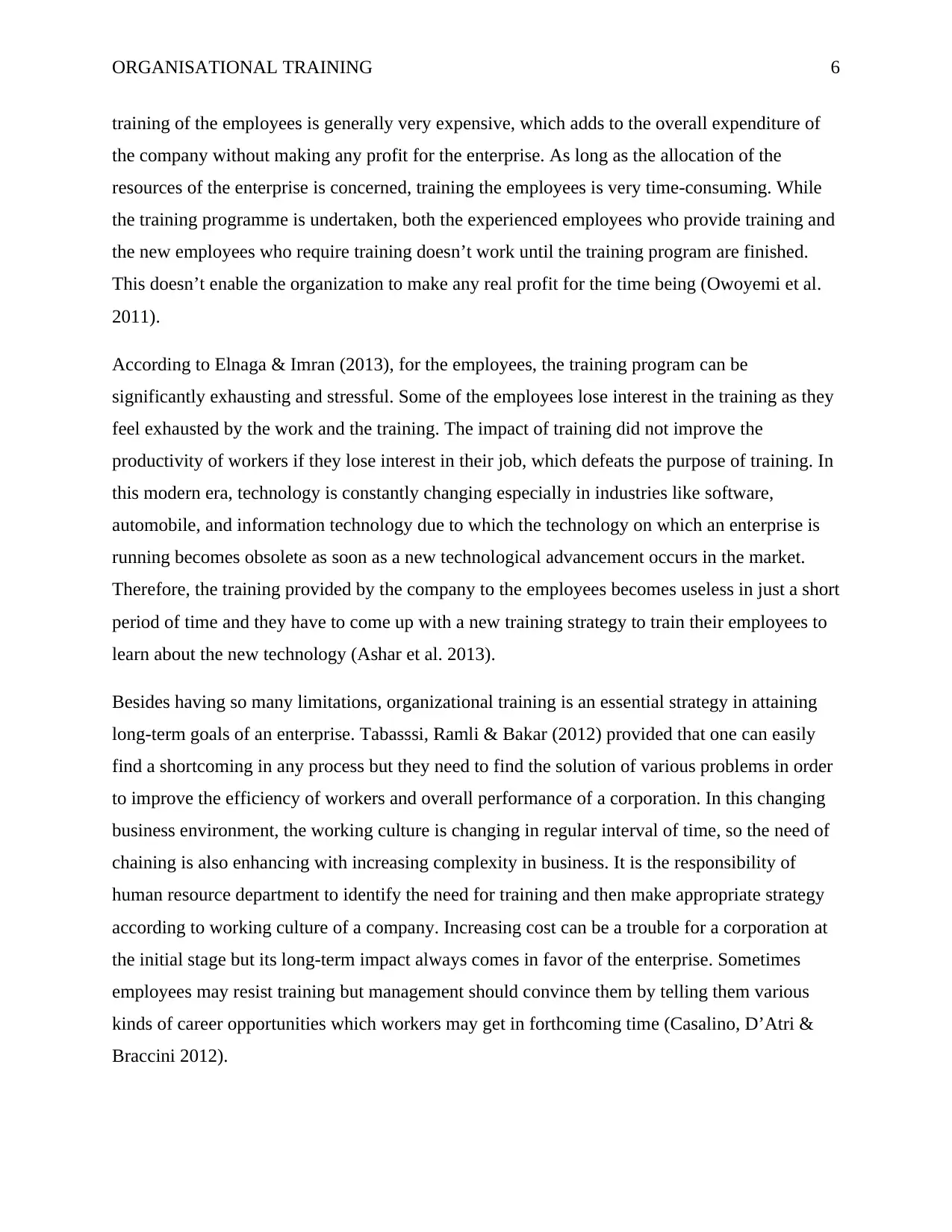
ORGANISATIONAL TRAINING 6
training of the employees is generally very expensive, which adds to the overall expenditure of
the company without making any profit for the enterprise. As long as the allocation of the
resources of the enterprise is concerned, training the employees is very time-consuming. While
the training programme is undertaken, both the experienced employees who provide training and
the new employees who require training doesn’t work until the training program are finished.
This doesn’t enable the organization to make any real profit for the time being (Owoyemi et al.
2011).
According to Elnaga & Imran (2013), for the employees, the training program can be
significantly exhausting and stressful. Some of the employees lose interest in the training as they
feel exhausted by the work and the training. The impact of training did not improve the
productivity of workers if they lose interest in their job, which defeats the purpose of training. In
this modern era, technology is constantly changing especially in industries like software,
automobile, and information technology due to which the technology on which an enterprise is
running becomes obsolete as soon as a new technological advancement occurs in the market.
Therefore, the training provided by the company to the employees becomes useless in just a short
period of time and they have to come up with a new training strategy to train their employees to
learn about the new technology (Ashar et al. 2013).
Besides having so many limitations, organizational training is an essential strategy in attaining
long-term goals of an enterprise. Tabasssi, Ramli & Bakar (2012) provided that one can easily
find a shortcoming in any process but they need to find the solution of various problems in order
to improve the efficiency of workers and overall performance of a corporation. In this changing
business environment, the working culture is changing in regular interval of time, so the need of
chaining is also enhancing with increasing complexity in business. It is the responsibility of
human resource department to identify the need for training and then make appropriate strategy
according to working culture of a company. Increasing cost can be a trouble for a corporation at
the initial stage but its long-term impact always comes in favor of the enterprise. Sometimes
employees may resist training but management should convince them by telling them various
kinds of career opportunities which workers may get in forthcoming time (Casalino, D’Atri &
Braccini 2012).
training of the employees is generally very expensive, which adds to the overall expenditure of
the company without making any profit for the enterprise. As long as the allocation of the
resources of the enterprise is concerned, training the employees is very time-consuming. While
the training programme is undertaken, both the experienced employees who provide training and
the new employees who require training doesn’t work until the training program are finished.
This doesn’t enable the organization to make any real profit for the time being (Owoyemi et al.
2011).
According to Elnaga & Imran (2013), for the employees, the training program can be
significantly exhausting and stressful. Some of the employees lose interest in the training as they
feel exhausted by the work and the training. The impact of training did not improve the
productivity of workers if they lose interest in their job, which defeats the purpose of training. In
this modern era, technology is constantly changing especially in industries like software,
automobile, and information technology due to which the technology on which an enterprise is
running becomes obsolete as soon as a new technological advancement occurs in the market.
Therefore, the training provided by the company to the employees becomes useless in just a short
period of time and they have to come up with a new training strategy to train their employees to
learn about the new technology (Ashar et al. 2013).
Besides having so many limitations, organizational training is an essential strategy in attaining
long-term goals of an enterprise. Tabasssi, Ramli & Bakar (2012) provided that one can easily
find a shortcoming in any process but they need to find the solution of various problems in order
to improve the efficiency of workers and overall performance of a corporation. In this changing
business environment, the working culture is changing in regular interval of time, so the need of
chaining is also enhancing with increasing complexity in business. It is the responsibility of
human resource department to identify the need for training and then make appropriate strategy
according to working culture of a company. Increasing cost can be a trouble for a corporation at
the initial stage but its long-term impact always comes in favor of the enterprise. Sometimes
employees may resist training but management should convince them by telling them various
kinds of career opportunities which workers may get in forthcoming time (Casalino, D’Atri &
Braccini 2012).
⊘ This is a preview!⊘
Do you want full access?
Subscribe today to unlock all pages.

Trusted by 1+ million students worldwide

ORGANISATIONAL TRAINING 7
Paraphrase This Document
Need a fresh take? Get an instant paraphrase of this document with our AI Paraphraser
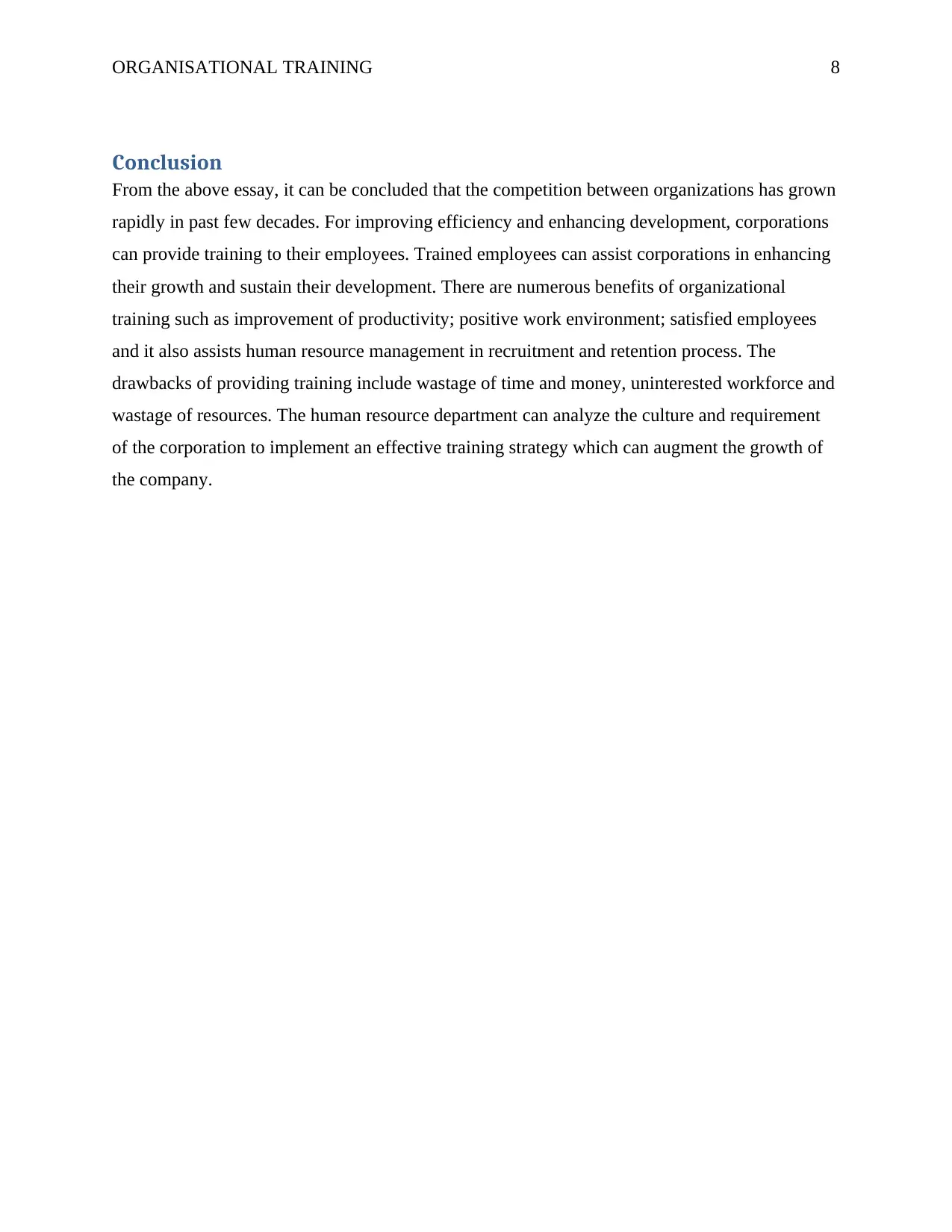
ORGANISATIONAL TRAINING 8
Conclusion
From the above essay, it can be concluded that the competition between organizations has grown
rapidly in past few decades. For improving efficiency and enhancing development, corporations
can provide training to their employees. Trained employees can assist corporations in enhancing
their growth and sustain their development. There are numerous benefits of organizational
training such as improvement of productivity; positive work environment; satisfied employees
and it also assists human resource management in recruitment and retention process. The
drawbacks of providing training include wastage of time and money, uninterested workforce and
wastage of resources. The human resource department can analyze the culture and requirement
of the corporation to implement an effective training strategy which can augment the growth of
the company.
Conclusion
From the above essay, it can be concluded that the competition between organizations has grown
rapidly in past few decades. For improving efficiency and enhancing development, corporations
can provide training to their employees. Trained employees can assist corporations in enhancing
their growth and sustain their development. There are numerous benefits of organizational
training such as improvement of productivity; positive work environment; satisfied employees
and it also assists human resource management in recruitment and retention process. The
drawbacks of providing training include wastage of time and money, uninterested workforce and
wastage of resources. The human resource department can analyze the culture and requirement
of the corporation to implement an effective training strategy which can augment the growth of
the company.
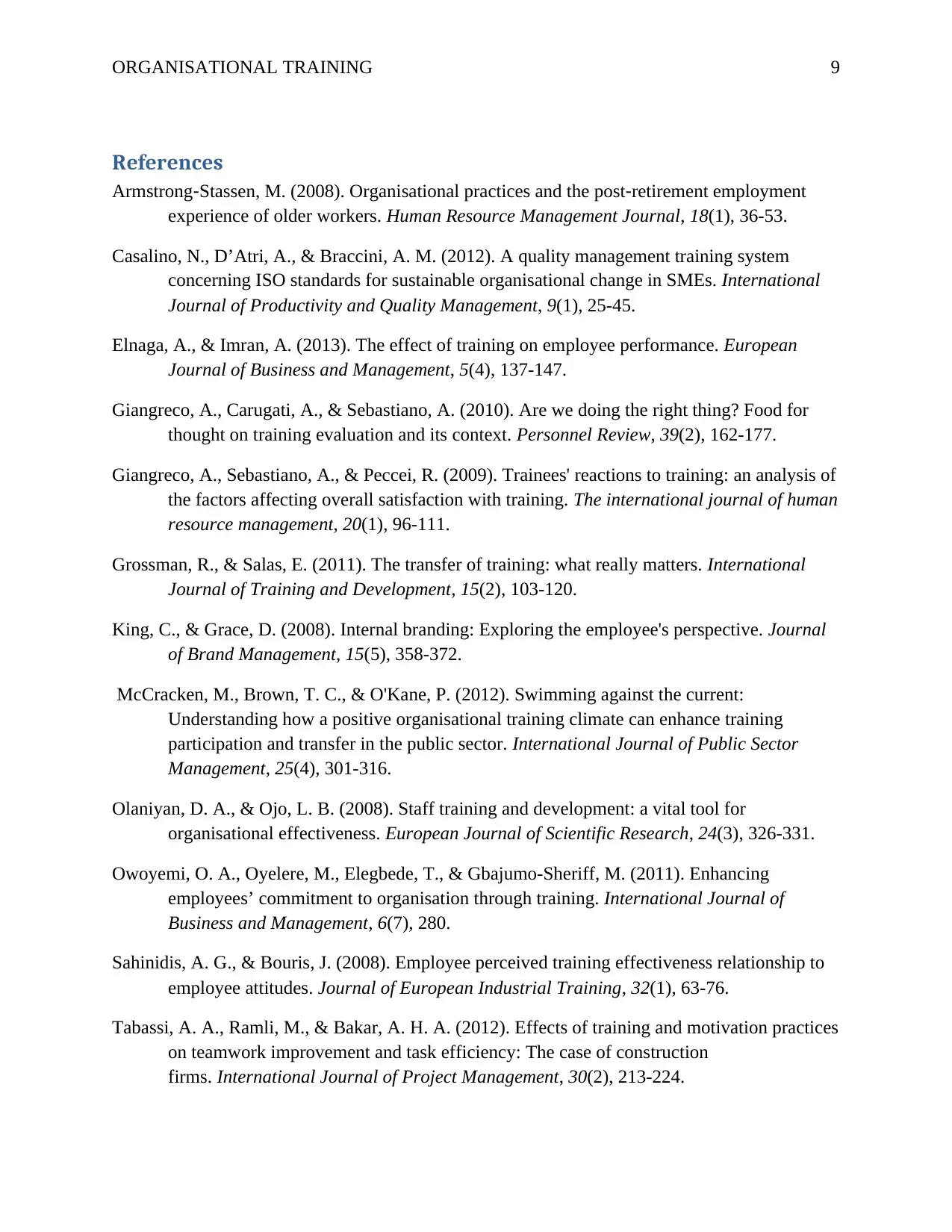
ORGANISATIONAL TRAINING 9
References
Armstrong‐Stassen, M. (2008). Organisational practices and the post‐retirement employment
experience of older workers. Human Resource Management Journal, 18(1), 36-53.
Casalino, N., D’Atri, A., & Braccini, A. M. (2012). A quality management training system
concerning ISO standards for sustainable organisational change in SMEs. International
Journal of Productivity and Quality Management, 9(1), 25-45.
Elnaga, A., & Imran, A. (2013). The effect of training on employee performance. European
Journal of Business and Management, 5(4), 137-147.
Giangreco, A., Carugati, A., & Sebastiano, A. (2010). Are we doing the right thing? Food for
thought on training evaluation and its context. Personnel Review, 39(2), 162-177.
Giangreco, A., Sebastiano, A., & Peccei, R. (2009). Trainees' reactions to training: an analysis of
the factors affecting overall satisfaction with training. The international journal of human
resource management, 20(1), 96-111.
Grossman, R., & Salas, E. (2011). The transfer of training: what really matters. International
Journal of Training and Development, 15(2), 103-120.
King, C., & Grace, D. (2008). Internal branding: Exploring the employee's perspective. Journal
of Brand Management, 15(5), 358-372.
McCracken, M., Brown, T. C., & O'Kane, P. (2012). Swimming against the current:
Understanding how a positive organisational training climate can enhance training
participation and transfer in the public sector. International Journal of Public Sector
Management, 25(4), 301-316.
Olaniyan, D. A., & Ojo, L. B. (2008). Staff training and development: a vital tool for
organisational effectiveness. European Journal of Scientific Research, 24(3), 326-331.
Owoyemi, O. A., Oyelere, M., Elegbede, T., & Gbajumo-Sheriff, M. (2011). Enhancing
employees’ commitment to organisation through training. International Journal of
Business and Management, 6(7), 280.
Sahinidis, A. G., & Bouris, J. (2008). Employee perceived training effectiveness relationship to
employee attitudes. Journal of European Industrial Training, 32(1), 63-76.
Tabassi, A. A., Ramli, M., & Bakar, A. H. A. (2012). Effects of training and motivation practices
on teamwork improvement and task efficiency: The case of construction
firms. International Journal of Project Management, 30(2), 213-224.
References
Armstrong‐Stassen, M. (2008). Organisational practices and the post‐retirement employment
experience of older workers. Human Resource Management Journal, 18(1), 36-53.
Casalino, N., D’Atri, A., & Braccini, A. M. (2012). A quality management training system
concerning ISO standards for sustainable organisational change in SMEs. International
Journal of Productivity and Quality Management, 9(1), 25-45.
Elnaga, A., & Imran, A. (2013). The effect of training on employee performance. European
Journal of Business and Management, 5(4), 137-147.
Giangreco, A., Carugati, A., & Sebastiano, A. (2010). Are we doing the right thing? Food for
thought on training evaluation and its context. Personnel Review, 39(2), 162-177.
Giangreco, A., Sebastiano, A., & Peccei, R. (2009). Trainees' reactions to training: an analysis of
the factors affecting overall satisfaction with training. The international journal of human
resource management, 20(1), 96-111.
Grossman, R., & Salas, E. (2011). The transfer of training: what really matters. International
Journal of Training and Development, 15(2), 103-120.
King, C., & Grace, D. (2008). Internal branding: Exploring the employee's perspective. Journal
of Brand Management, 15(5), 358-372.
McCracken, M., Brown, T. C., & O'Kane, P. (2012). Swimming against the current:
Understanding how a positive organisational training climate can enhance training
participation and transfer in the public sector. International Journal of Public Sector
Management, 25(4), 301-316.
Olaniyan, D. A., & Ojo, L. B. (2008). Staff training and development: a vital tool for
organisational effectiveness. European Journal of Scientific Research, 24(3), 326-331.
Owoyemi, O. A., Oyelere, M., Elegbede, T., & Gbajumo-Sheriff, M. (2011). Enhancing
employees’ commitment to organisation through training. International Journal of
Business and Management, 6(7), 280.
Sahinidis, A. G., & Bouris, J. (2008). Employee perceived training effectiveness relationship to
employee attitudes. Journal of European Industrial Training, 32(1), 63-76.
Tabassi, A. A., Ramli, M., & Bakar, A. H. A. (2012). Effects of training and motivation practices
on teamwork improvement and task efficiency: The case of construction
firms. International Journal of Project Management, 30(2), 213-224.
⊘ This is a preview!⊘
Do you want full access?
Subscribe today to unlock all pages.

Trusted by 1+ million students worldwide

ORGANISATIONAL TRAINING 10
Zheng, C., & Lamond, D. (2010). Organisational determinants of employee turnover for
multinational companies in Asia. Asia Pacific journal of management, 27(3), 423-443.
Ashar, M., Ghafoor, M., Munir, E., & Hafeez, S. (2013). The impact of perceptions of training
on employee commitment and turnover intention: Evidence from Pakistan. International
journal of human resource studies, 3(1), 74.
Zheng, C., & Lamond, D. (2010). Organisational determinants of employee turnover for
multinational companies in Asia. Asia Pacific journal of management, 27(3), 423-443.
Ashar, M., Ghafoor, M., Munir, E., & Hafeez, S. (2013). The impact of perceptions of training
on employee commitment and turnover intention: Evidence from Pakistan. International
journal of human resource studies, 3(1), 74.
1 out of 10
Related Documents
Your All-in-One AI-Powered Toolkit for Academic Success.
+13062052269
info@desklib.com
Available 24*7 on WhatsApp / Email
![[object Object]](/_next/static/media/star-bottom.7253800d.svg)
Unlock your academic potential
Copyright © 2020–2025 A2Z Services. All Rights Reserved. Developed and managed by ZUCOL.





